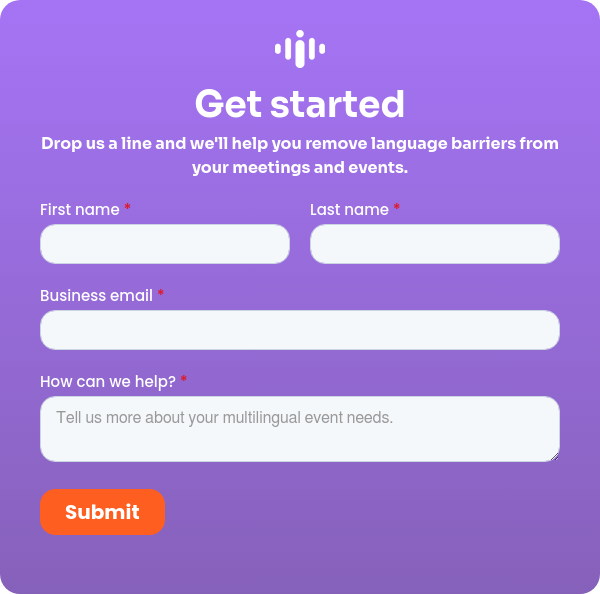For many businesses, expanding into new markets is the key to growth. However, as you move into other regions, partner with suppliers, and draw from the global talent pool, language barriers will undoubtedly emerge. Language issues remain a persistent problem for many organisations. As a Forbes Insights and Rosetta Stone Business report reveals, more than 100 executives at large US businesses find that language barriers have a “significant impact” on business operations.
This is why live translation solutions are so helpful for businesses looking to expand or start hiring internationally. In this article, we highlight six reasons to consider live translation solutions for your business.
6 ways live translation solutions overcome language barriers in international companies
1. Improved internal collaboration
Did you know that 46% of employees working in global companies can’t communicate effectively due to language barriers? Another 40% are less productive due to language issues, according to the Rosetta Stone report highlighted earlier.
For many companies operating globally, language barriers are a consistent struggle impacting internal collaboration. Worse, poor communication can also lead to misunderstandings, misinterpretations, and even morale-damaging conflict.
Using solutions that ensure effective communication in real-time can greatly decrease the likelihood of communication breakdown. By facilitating easy communication, live translation enables immediate problem-solving and decision-making, enhancing responsiveness to market changes and customer needs.
2. Easier expansion and localisation for new markets
Expanding into new markets often requires businesses to adapt their products or services to local preferences. Without live translation solutions, language barriers can hinder adaptation.
However, with live translation solutions, businesses can localise their products and services, helping them connect with their target audience and successfully enter a certain market.
Take Netflix, for example. They invested heavily in localising their content, offering subtitles, dubbing, and interfaces in various languages. This approach significantly enhanced viewer experience in different countries, making their service more accessible and appealing to local audiences. By prioritising language inclusivity, Netflix successfully broadened its international reach and subscriber base.
While your business might not take the same approach as Netflix, removing language barriers will support your localisation efforts.
3. Enhanced customer service and experiences
If your client-facing teams don’t speak your customer’s language, they may struggle to understand the issues customers face. This can lead to inadequate or frustrating customer experiences. Providing poor experiences has a huge impact on customer retention. After all, 37% of customers leave a brand after having one bad experience — according to a recent PwC study.
Live translation enables your customer service team to overcome language barriers, provide better support, and offer better customer experiences.
4. Reduced legal and compliance risks
Laws and regulations differ between markets. This means that, when companies expand into new regions, employees must be aware of the legal and regulatory requirements for those regions. As the saying goes: “Ignorance of the law does not protect you from the consequences of breaking the law.”
But training your employees isn’t easy. For 42% of multinational companies, training employees on relevant policies was cited as a top challenge, along with aligning policies to changing regulations — as revealed by a recent Navex Global risk and compliance report.
By utilising real-time translation services, businesses can make training sessions on legal and regulatory compliance accessible to employees in their native languages. This approach is not only inclusive but also ensures that the nuances and specifics of compliance requirements are understood universally, regardless of language barriers. This is vital. Miscommunication, especially in the context of legal and regulatory matters, can lead to severe repercussions.
5. Faster decision-making
For many global businesses, quick decision-making is a necessity for success. This is even more pronounced when dealing with international teams, where language barriers can inadvertently become hurdles.
Consider this: a staggering 67% of executives surveyed by Rosetta Stone pointed out that miscommunication due to language barriers creates inefficiencies. This underlines a critical challenge in global operations — slower decision-making due to language-related misunderstandings. And the slower the decision-making, the slower your business will adapt to market shifts and seize opportunities.
A live translation solution can address these issues by providing real-time, accurate translations during discussions and meetings. By bridging the language gap instantly, translation tools minimise communication delays, allowing diverse global teams to make faster, more informed decisions.
A McKinsey study reinforces this point: businesses that make faster decisions are better able to capitalise on opportunity and drive profit. As such, their decisions are likely to generate 20% higher returns compared to their slower counterparts.
6. Improved employee morale and productivity
Workplace language barriers can set off a chain reaction, where poor communication increases stress, which decreases productivity, which further hampers communication. Poor communication is such a pervasive issue that a whopping 89% of office workers are impacted by bad communication — according to a TechReport article. These workers also link poor communication with increased stress and lower efficiency.
Low morale has a huge impact on revenue. According to a recent Gallup report, disengaged employees contribute to an estimated $8.8 trillion loss in global productivity. Without the means to effectively communicate, the gap between employees widens, leaving them feeling unsupported and undervalued. The solution lies in addressing this communication gap head-on.
Live language translation tools are a transformative step towards bridging these divides. By empowering employees to communicate seamlessly, regardless of their native language, businesses can foster a more inclusive and supportive environment. This sets off a more positive chain reaction — better morale, enhanced productivity, and a greater sense of belonging among the workforce.
Investing in live translation: What are the options?
Understanding the need for a live translation solution is the first step in bridging communication gaps in your global business operations. As you explore your options, consider Interprefy's innovative language solutions. Our solutions include:
- Remote Simultaneous Interpretation (RSI) — real-time language interpretation provided by veteran interpreters who can work from anywhere in the world.
- Live Captions and Subtitles — precise real-time subtitles and captions that make speech accessible for multiple languages and for those with hearing impairments.
- AI Speech Translation — a scalable, cost-effective, and award-winning AI solution that enables instant speech-to-text translation, live subtitles, and captions.
Which solution is right for you?
If you’re wondering which solution best aligns with your requirements, then please reach out to the Interprefy team. We can discuss your unique challenges and how our language tools can help you achieve your business goals.






.webp?width=468&quality=high)




 More download links
More download links



